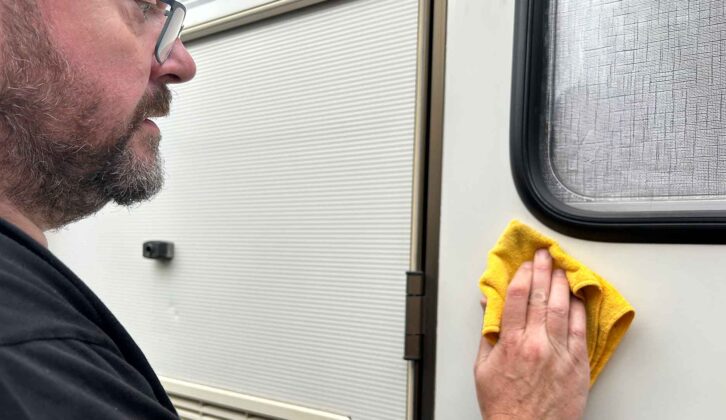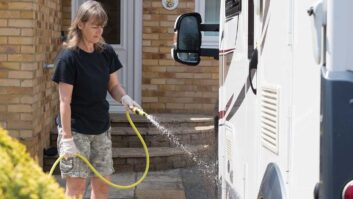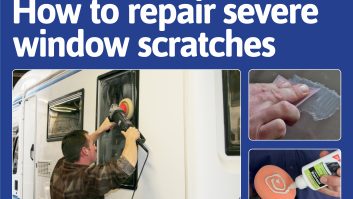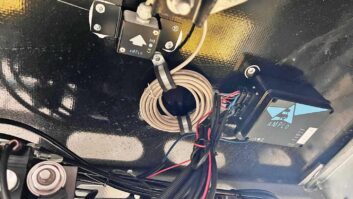The prospect of polishing a motorhome can feel daunting, but it’s a maintenance task that is very worth doing. This is because it will not only help to protect your motorhome, but also keep it looking its best.
Practical Motorhome is supported by its audience. When you purchase through links on our site, we may earn an affiliate commission. Learn more
Knowing how to polish a motorhome and carrying out this important job will also be particularly useful if you’re thinking about selling your motorhome down the line, with a well-cared-for and spotless ‘van more likely to catch the eye of a buyer. Here, I’ll talk you through the process.
First things first. You’re going to need to carry out the task of cleaning a motorhome, taking care to get rid of any dirt and grit on the surfaces. This is an important step, as failing to clean it effectively could result in you inadvertently rubbing contaminants into the bodywork when you’re polishing the motorhome. This, in turn, could lead to micro-scratch swirls in the surface finish.
This is a job you should have the best motorhome cleaner for – at Practical Motorhome, we particularly like Autoglym Motorhome and Caravan Cleaner or Fenwicks Motorhome Cleaner.
After successfully cleaning the ‘van, it will be time to reach for the best motorhome polish – we like ones from Autoglym, Silky, or Care-avan. At this stage, I will point out that you don’t necessarily need a specific ‘motorhome polish’, as you will find the ingredients are similar for cars, boats and motorhomes. However, the better brands (which are going to be more expensive) are likely to have more of the good stuff.
When it comes to applying the polish to the motorhome, use a sponge pad or a clean cloth – the typically suggested method of application is rubbing the polish on in a circular motion, with the solution being worked into the surface.
Leave it to dry for a few minutes before buffing it off with a clean microfibre cloth. If you’re doing this job on a hot day, we’d advise doing it in the evening, so the motorhome’s surface temperature will be lower.
Polishing a motorhome helps to make both the walls and roof hydrophobic, meaning rainwater beads and rolls off the surface. It also has the added benefit of creating a microscopically thin protective shell, which offers protection against tree sap and bird droppings, so they will be easier to clean off in the future.
If you so desire, you could decide to get a ceramic coating from a brand such as Paintseal or Diamondbrite. Generally applied by a technician, this coating provides your motorhome with an invisible but tough protective layer which will subsequently make cleaning your ‘van easier and also help it to resist dirt. They have the benefit of lasting for a few years too.
You could also find that the glass fibre finish on an older motorhome has started drying out and is looking powdery – if this is the case, a quality polish will help to hide the worst of the deterioration, and restore some shine. Another option could be Owatrol Gelcoat and Surface Restorer – this is a ‘repair solution’ which can be used on faded or dull surfaces.
When you are cleaning a ‘van, the dirtiest part can be the roof, so you will want to make sure you don’t forget to give it some attention – my guide to motorhome roof cleaning talks you through the process.
Future Publishing Limited, the publisher of Practical Motorhome, provides the information in this article in good faith and makes no representation as to its completeness or accuracy. Individuals carrying out the instructions do so at their own risk and must exercise their independent judgement in determining the appropriateness of the advice to their circumstances and skill level. Individuals should take appropriate safety precautions and be aware of the risk of electrocution when dealing with electrical products. To the fullest extent permitted by law, neither Future nor its employees or agents shall have any liability in connection with the use of this information. You should check that any van warranty will not be affected before proceeding with DIY projects.
If you’ve enjoyed reading this article, why not get the latest news, reviews and features delivered direct to your door or inbox every month. Take advantage of our brilliant Practical Motorhome magazine SUBSCRIBERS’ OFFER and SIGN UP TO OUR NEWSLETTER for regular weekly updates on all things motorhome related.









